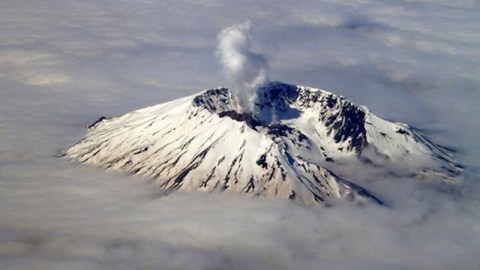Two US volcanoes making news: Kilauea and St. Helens

We’ve talked a lot about volcanoes in other parts of the world, but now we have two US volcanoes making some news (although neither because they’re having a large eruption):
Hawai`i: The lava lake at the Halema`uma`u Crater in Kilauea has reached new heights – in fact, the lava lake had gotten high enough (~77 meters below the crater floor) in the pit crater that there was some thoughts that it might spill out onto the floor of the crater. However, that fate is unclear now as the pit crater itself is collapsing into the lava lake, with large chunks of the rim falling in on Monday. These chunks, some as large as 120 meters x 5 meters, fell into the lake and produced small plumes of ash and gases along with very obvious popping sounds heard as far as half a mile away. You can hear some of the noises and watch some quicktime movies of the activity at the Halema`uma`u Crater over on the Hawaii Volcano Observatory website. Collapses in the pit crater in 2009 blocked off the lava lake from view, but quickly the lava was able to retake the crater. Seismicity related to the upper east rift zone of lava seemed to peak late last week, which might suggest that the influx of new basaltic magma might be waning. Be sure to check out the great time lapse videos (this one from Pu`u O`o) from Eruptions readers along with all the Kilauea the webcams as well. UPDATE: Speaking of Pu`u O`o time lapse video, here is a new one from the USGS as well.
Washington: Back in the continental United States, the earthquake swarm underneath Mount St. Helens appears to be continuing, albeit in a bit of a sporadic fashion. A magnitude 4.3 earthquake occurred ~10 km to the north of the crater on Monday and along with a number of smaller aftershocks, were all located at ~4-7 km depth. The USGS is, not surprisingly, keeping an eye on these earthquakes but the indications don’t seem to be pointing to any impending eruption at St. Helens. The earthquake, the largest in 30 years at the volcano, was large enough to be felt by some people in the area near the volcano and in Portland (thus all the horrible “Love waves on Love Day” puns – Love waves are the side-to-side surface waves in an earthquake). Dr. Bill Steele of the University of Washington Geophysics Lab said that this swarm is not unexpected in the area but it is “awfully vigorous” and that this seismicity might be related to changes in the stress field near St. Helens. These changes are usually associated with moment of magma or cooling of magma under the edifice. Remember, you can see all the seismic activity in the Cascades on the PNSN webicorder page.
Top left: An undated aerial image of Mount St. Helens, Washington.





